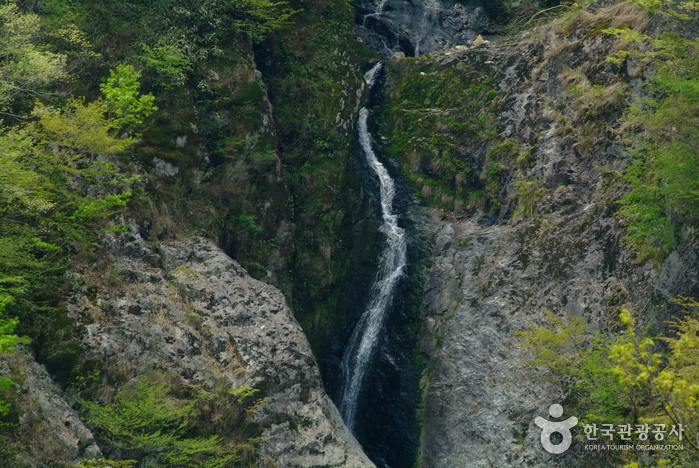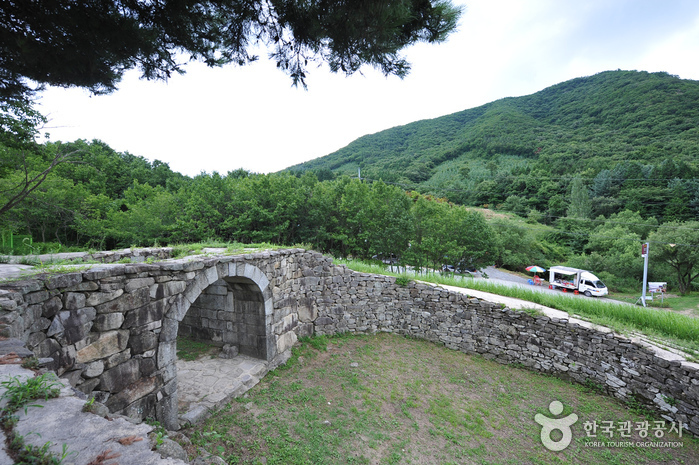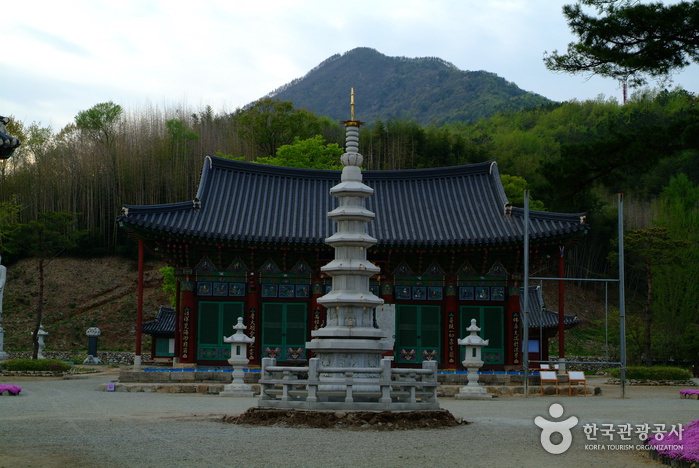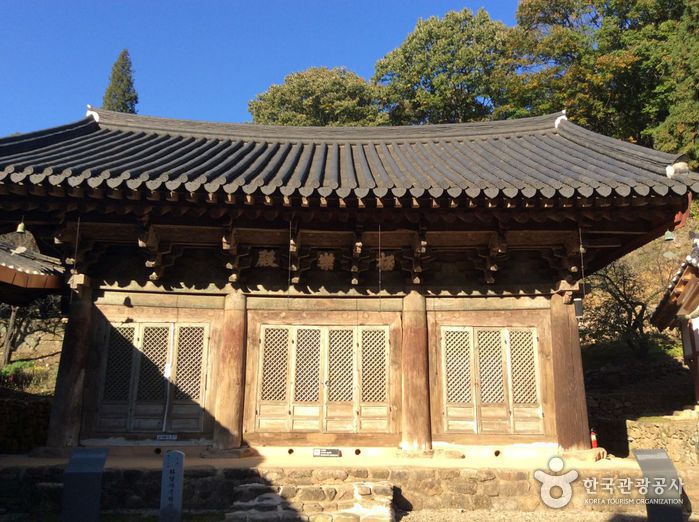NocWoonJae [Korea Quality] / 녹운재 [한국관광 품질인증]
8.6Km 6132 2024-04-07
472-18 , Songgwangsuman-ro, Wanju-gun, Jeonbuk-do
+82-10-4450-6565
Nokwoonjae is a guest hanok in Oseong Hanok Village, Wanju-gun, Jeollabuk-do. It comprises two houses built on sloping land - Naunchae above and Unahchae below - with a corridor connecting the two. All rooms are built of timber and red clay - beneficial to both mind and body - and have large windows to let you enjoy natural views and breezes.Toast, jam, and milk are provided for breakfast, and self-catering is possible. Sagunja painting and tea ceremony experiences are offered, while local visitor destinations include Songgwangsa Temple, Wibongsa Temple, the 60m Wibong Falls (one of Wanseon’s ‘Eight Splended Views’) and Jeonju Hanok Village.
Wibongpokpo Falls (위봉폭포)
8.7Km 18328 2024-04-07
Daeheung-ri, Wanju-gun, Jeonbuk-do
+82-63-290-3930
Located in the eastern section of Wibongsanseong Fortress, Wibongpokpo Falls is a two-tiered waterfall measuring 60 meters high. The strangely-shaped rocks and thick groves of trees that border the cascading falls make for such a magical scene that it comes as no surprise that the waterfall has long since been counted as one of the Eight Scenic Sights of Wansan. Attractions located nearby include a battlefield from the Imjin War (1592-1598), Songgwangsa Temple, Dongsang Reservoir, Daea Reservoir, and Hwasim Hot Springs.
Wibongsanseong County Park (위봉산성군립공원)
8.8Km 11502 2024-04-07
Daeheung-ri, Wanju-gun, Jeonbuk-do
+82-63-240-4224
Wibongsanseong County Park is located north of Jeonju, past Songgwangsa Temple through a tunnel of cherry trees. The park has some noteworthy sightseeing attractions such as Wibongpokpo Falls, Wibongsa Temple, and Dongsang Reservoir. Winbongsanseong County Park was founded at the site of Winbongsanseong Fortress, which was built under King Sukjong's rule in 1675 as a refuge site to safekeep the portrait of Joeson dynasty's founder King Taejo and the royal family's ancestral tablet in times of war or other national emergency. They are originally enshrined in Gyeonggijeon Shrine and Jogyeongmyo Shrine, and when Jeonju had fallen during the Donghak Peasant Revolution, the portrait and tablet were moved to a small palace inside the fortress. The original fortress walls were 16 kilometers in circumference with three gates in the north, east, and west, but only a half-moon shaped western gate remains standing today.
Daea Arboretum (대아수목원)
8.8Km 39641 2024-04-07
94-34, Daeasumok-ro, Dongsang-myeon, Wanju_Gun, Jeonbuk-do
+82-63-280-4590
Daea Arboretum is located in Sancheon-ri, Wanju. Daea Arboretum has an extensive forest of 300,000 ornamental trees. The forest is equipped with spring water, an observatory, forest museum, and a forest classroom. The arboretum focuses on preserving the forest ecosystem, research and utilize domestic plants, and promote forest education to the public. Daea Arboretum has a total of 2,683 species of diverse plants.
Wanggung Dawon (왕궁다원)
10.0Km 0 2024-04-07
21-5 Sagok-gil, Wanggung-myeon, Iksan-si, Jeonbuk-do
Wanggung Dawon is a hanok café built in the 1800s. It was once the residence of Song Byungwoo, a rich person in the region, and has been operating as a traditional tea house since 2008, preserving the charm of the old hanok. The café offers a wide variety of teas, with the signature menu item being ssanghwatang (herbal tonic tea), a traditional Korean beverage. Ssanghwatang is made with ingredients such as jujube, ginseng, and chestnuts, known for its warming properties.
Wanju Songgwangsa Temple (송광사(완주))
10.5Km 20795 2024-04-07
255-16, Songgwangsuman-ro, Wanju-gun, Jeonbuk-do
+82-63-243-8091
Songgwangsa Temple in Wanju-gun, Jeollabuk-do has a unique history that spans a period of over a thousand years. For many years the temple lay incomplete until Monk Bojo Chejing began reconstruction in the 7th year of King Gyeongmun of Silla (AD 867). The temple was destroyed at one point in time, but Master Monk Jinul prayed that it be rebuilt. In accordance with his fervent hopes, in the 1600s the monk’s followers rebuilt a number of the temple’s halls and buildings, many of which can still be seen today. The temple is also remembered as the temple that King Injo helped rebuild with the hope that his two sons, who had been taken hostage by the Qing dynasty during the Byeongjahoran War (Chinese invasion of Korea in 1636), would be returned safely and that Buddha would heal the nation.
One of the Korea’s four major temples, Songgwangsa is home to Jijangbosal and Siwangsang statues (found in Jijangjeon Hall), a Seokgayeorae statue, and 500 Nahansang statues (found in Nahanjeon Hall). The temple is also home to eight Tangible Cultural Assets and four Treasured Cultural Assets: Daeungjeon Hall, the Samsebulsang statues, the bell-tower, and the Sacheonwangsang statue.
Beloved for its historical significance as well as its beauty, the temple draws throngs of worshipers throughout the year. In spring, many tourists flock to the area to explore the temple and walk through the nearby cherry blossom tunnels. A worthwhile attraction for visitors of all ages, the temple is particularly well-suited for those with mobility problems since it is located on ground level.
Oseongje Reservoir (오성제 저수지)
11.7Km 0 2024-07-18
Daeheungmunhwa-gil, Soyang-myeon, Wanju-gun, Jeonbuk-do
Oseongje Reservoir provides a natural rest area for locals with a waterside path. Located nearby is a gallery and photo spot. The area quickly became a must-visit attraction after featuring in BTS' 2019 Summer Package.
Doejae Catholic Church (되재성당)
12.4Km 0 2024-04-07
477 , Seungchi-ro, Wanju-gun, Jeonbuk-do
Doejae Catholic Church, built in 1895, is the second Catholic church to be completed after Yakhyeon Catholic Church in Seoul and is known as the first Hanok Catholic church. The building was completely destroyed during the Korean War and was restored in 2008. The name 'Doejae' refers to a pass located in Seungchi-ri, Hwasa-myeon, Wanju-gun. Doejae Catholic Church is unique in that it has an entrance for each toenmaru. The left side is for men and the right side is for women. In addition, the gates of children, middle-aged, and elderly are classified according to the funeral will.
Wanju Hwaamsa Temple (화암사(완주))
12.5Km 23321 2024-04-07
271 , Hwaamsa-gil, Wanju-gun, Jeonbuk-do
The temple was founded by National Preceptor Ilgyo in the 3rd year of King Hyoso of Silla (694), and it is said that Seolchong once studied here. Geuknakjeon Hall was built in 1425 with the benefactor of Seong Dal-saeng. Uhwaru is also designated as a treasure as a building that shows the characteristics of ancient architecture. The bronze bell made during the reign of King Gwanghaegun was cast by Hoyeong, and it is called the alarm clock because it made a sound when something unfortunate happened to the temple or the country to inform of the emergency. Hwaamsa Temple is surrounded by the primeval forest of Myeongsan Mountain like a folding screen and has a valley with clear water flowing.
* Major cultural assets: Hwaamsa Uhwaru (Treasure), Hwaamsa Geuknakjeon (National Treasure), Hwaamsa Bronze Bell (Local Tangible Cultural Property), Hwaamsa Reconstruction Monument (Local Tangible Cultural Property)
Olive Young - Jeonju Eco City Branch [Tax Refund Shop] (올리브영 전주에코시티점)
13.2Km 0 2024-06-27
#101, 30, Sebyeong-ro, Deokjin-gu, Jeonju-si, Jeonbuk-do
-
![NocWoonJae [Korea Quality] / 녹운재 [한국관광 품질인증]](http://tong.visitkorea.or.kr/cms/resource/71/2049271_image2_1.jpg)





 English
English
 한국어
한국어 日本語
日本語 中文(简体)
中文(简体) Deutsch
Deutsch Français
Français Español
Español Русский
Русский